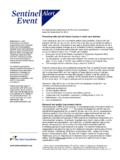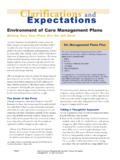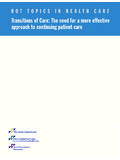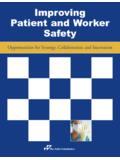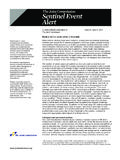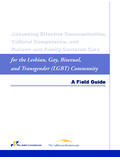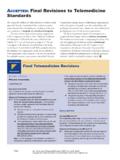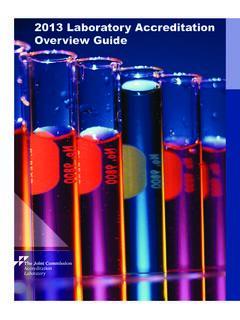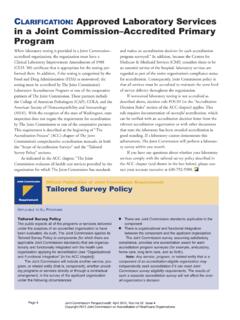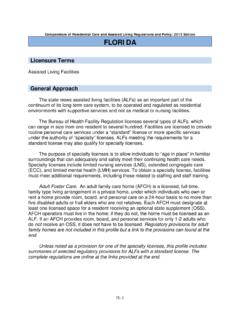Transcription of Measuring Hand Hygiene Adherence - Joint Commission
1 Measuring Hand Hygiene Adherence : Overcoming the Challenges Measuring . HAND Hygiene . Adherence : OVERCOMING. THE CHALLENGES. This monograph was authored by The Joint Commission in collaboration with the following organizations: The Association for Professionals in Infection Control and Epidemiology, Inc. The Centers for Disease Control and Prevention The Institute for Healthcare Improvement The National Foundation for Infectious Diseases The Society for Healthcare Epidemiology of America The World Health Organization World Alliance for Patient Safety This monograph was supported in part by an unrestricted educational grant provided by GOJO Industries, Inc., Akron, Ohio The Joint Commission Mission The mission of The Joint Commission is to continuously improve the safety and quality of care provided to the public through the provision of health care accreditation and related services that support performance improvement in health care organizations. 2009 The Joint Commission All rights reserved.
2 No part of this publication may be reproduced in any form or by any means without written permis- sion from the publisher. Printed in the 5 4 3 2 1. Requests for permission to make copies of any part of this work should be mailed to: Division of Quality Measurement and Research The Joint Commission One Renaissance Boulevard Oakbrook Terrace, Illinois 60181. 630-792-5938. The monograph was produced as part of the Consensus Measurement in Hand Hygiene (CMHH) project. The goal of the CMHH project is to identify promising, practical techniques for Measuring Adherence to hand Hygiene guidelines. This monograph is the result of a two-year collaboration involving The Joint Commission and six collaborating organiza- tions: The World Health Organization (WHO) World Alliance for Patient Safety (WAPS), the Association for Professionals in Infection Control and Epidemiology, Inc. (APIC), the Centers for Disease Control and Prevention (CDC), the Society for Healthcare Epidemiology of America (SHEA), the Institute for Healthcare Improvement (IHI), and the National Foundation for Infectious Diseases (NFID).
3 The findings and conclusions in this report are those of the authors and do not necessarily represent the position of the Centers for Disease Control and Prevention or any of the other collaborating organizations. The project was funded in part by an unrestricted educational grant from GOJO Industries, Inc., Akron, Ohio, which had no involvement in the design, implementation, analysis, results, or review of reports from the project. Many of the examples included in this monograph come from self-reported methods, tools, and data submitted by health care organizations to the CMHH project, as well as published literature. Examples included in this monograph are intended to aid health care organizations in their own hand Hygiene efforts and should not necessarily be considered evi- dence based. Inclusion of any reference or example should not be construed as an endorsement of any measurement method, product, treatment, or program discussed therein. The inclusion of a vendor, product name, or service should not be con- strued as an endorsement of such vendor, product, or service, nor is failure to include the name of a vendor, product, or service to be construed as disapproval.
4 The CMHH project staff are solely responsible for the monograph content. We have worked to ensure that this mono- graph contains useful information, but this monograph is not intended to be a comprehensive source of all relevant information. In addition, because the information contained herein is derived from many sources, the Joint Commission and its collaborating organizations cannot guarantee that the information is completely accurate or error free. The Joint Commission and its collaborating organizations are not responsible for any claims or losses arising from the use of, or from any errors or omissions in, this monograph. For more information about The Joint Commission , please visit CONTENTS. Executive Summary xvii Introduction xxi Purpose and Intended Audience xxi The Consensus Measurement in Hand Hygiene (CMHH) Project xxi Why Measuring Adherence to Hand Hygiene Guidelines is Important xxii Challenges to Measuring Hand Hygiene Adherence : Why it is Not Easy xxii Scope of this Monograph xxiii References xxiv Chapter 1: Hand Hygiene Guidelines: The Foundation for Measurement 1.
5 Factors Influencing Adherence to Hand Hygiene Guidelines 2. Hand Hygiene Indications, Opportunities, and Actions: Understanding the Terminology 2. Key Points, Chapter 1 5. References 5. Chapter 2: Developing a Strategy for Measuring Hand Hygiene 13. Why Do You Want to Measure Hand Hygiene Practices, and What Are Your Organization's Goals? 13. What Elements of Hand Hygiene Do You Want to Measure? 13. How Do You Want to Measure Hand Hygiene ? 14. Using Multiple Methods to Measure Hand Hygiene 15. Key Points, Chapter 2 16. References 16. Chapter 3: Observing Adherence to Hand Hygiene Guidelines 19. Strengths and Limitations of the Observation Method 19. Components of the Measurement Method 20. Selecting Which Opportunities to Measure 20. Deciding What Aspects to Observe 20. Type of Product or Agent Used 20. Thoroughness of Cleansing 20. Glove Use 21. iii Measuring HAND Hygiene Adherence : OVERCOMING THE CHALLENGES. Determining Who to Observe 21. Conducting Observations 22. Dealing with Double Counting Opportunities 22.
6 Determining When and How Frequently to Observe 22. Determining How Many Observations Are Needed 23. Determining Where to Measure: Structuring and Scheduling Your Observations 24. Selecting a Sample of Health Care Workers or Patients to Observe 24. Determining Who Will Conduct Observations 25. Infection Preventionists 25. Advantages 25. Disadvantage 25. Other Personnel 25. Patients 25. Overt Versus Covert Observation 26. Privacy Considerations 28. Using Technology in Observations 28. Standardizing Observation (Consistency and Reliability) 29. The Importance of Observer Training and Assessing Reliability 29. Documenting Your Methods 29. Determining How to Calculate Adherence Rates 29. Item-by-Item Measures 30. Composite Measures 31. All-or-None Measures 31. Key Points, Chapter 3 32. References 33. Chapter 4: Measuring Product Use 53. Strengths and Limitations of the Product Measurement Method 53. Strengths of Measuring Product Use 53. Limitations of Measuring Product Use 54. Components of the Measurement Method 54.
7 Measuring the Amount of Product Used 54. Measuring the Frequency of Product Use 55. Electronic Counting Devices 55. Electronic Monitoring Systems 57. Estimating Adherence Rates with Product Use Data 58. Customizing Calculations to Specific Units 58. Tools and Systems for Aggregating and Comparing Information 58. Key Points, Chapter 4 60. References 60. Chapter 5: Conducting Surveys 63. Strengths and Limitations of Using Surveys 63. Strengths of Using Surveys 63. Limitations of Using Surveys 64. iv Contents Components of Hand Hygiene that Surveys can Assess 64. Staff Knowledge 65. Staff Attitudes and Beliefs 65. Staff Self-Perceptions of Hand Hygiene Behavior 65. Structural Factors and Considerations 66. Patient or Family Satisfaction with Staff Performance 66. Staff Satisfaction with Products 66. assessment of skin Condition 66. Key Points, Chapter 5 67. References 67. Chapter 6: Assessing the Thoroughness of Hand Hygiene and Related Aspects 73. Observing Hand Hygiene Technique 73.
8 Physical Measurements of Hand Hygiene 75. Microbiological Methods for Assessing Thoroughness 77. Other Aspects of Hand Hygiene : Nail Length, Artificial Nails, Wearing of Rings, and Glove Use 78. Nail Length and Artificial Nails 78. Wearing of Rings 80. Monitoring the Use of Gloves 80. Key Points, Chapter 6 81. References 81. Chapter 7: International Hand Hygiene Measurement Tools and Improvement 87. Efforts: Leading the Way to Broadscale Change Worldwide Efforts: The WHO Global Patient Safety Challenge, Clean Care Is Safer Care 87. WHO Observation Tool 87. National and Regional Efforts 88. England and Wales: cleanyourhands Campaign 88. The Hand Hygiene Observation Tool 88. Ontario, Canada: Just Clean Your Hands Program 89. Ontario Observation Tool 89. New South Wales, Australia: Clean Hands Save Lives Campaign 90. New South Wales Data Collection Tools 90. Campaign Achievements 90. Health Protection Scotland: Germs. Wash Your Hands of Them 91. Data Collection Tools and Auditing Method 91.
9 Campaign Achievements 92. Testing of a Measurement Tool for Use in Developing Countries 92. Key Points, Chapter 7 92. References 92. Chapter 8: Displaying and Interpreting Hand Hygiene Data for Maximum Effectiveness 95. Creating a Hand Hygiene Dashboard 95. Reporting Data by Unit and Type of Health Care Worker 95. Statistical Process Control Charts 95. v Measuring HAND Hygiene Adherence : OVERCOMING THE CHALLENGES. Associating Process Measures of Hand Hygiene with the Outcome of Infection Rates 96. Key Points, Chapter 8 102. References 103. Chapter 9: Measurement Is Only the Beginning: Factors That Contribute to Improvement 107. Complexity of Changing Behavior 107. Effective Models and Strategies for Hand Hygiene Behavior Change 107. Factors That Affect the Success of Improvement Initiatives 108. Use of Effective Strategies 109. Education and Training 110. Audit and Feedback 110. Reminders 110. Use of Multidisciplinary Teams 110. Systematic Performance Improvement Methods 111. Other Strategies 111.
10 Organizational and System Characteristics 111. Structural Capacity 111. Policies, Procedures, and Processes 111. Leadership 113. Administration Leaders 113. Clinical Leaders: The Importance of Role Models 113. Accountability 114. Leaders of the Improvement Initiative 114. Safety Culture 114. Personnel 114. Staff Engagement 115. Incentives and Rewards 115. Involvement of Patients and Families 115. External Environment 116. What is Success? 116. Key Points, Chapter 9 118. References 119. Chapter 10: Resources for Measurement and Improvement 121. Resources from Organizations Collaborating in Monograph Development 121. Association for Professionals in Infection Control and Epidemiology, Inc. 121. Centers for Disease Control and Prevention 121. Institute for Heathcare Improvement 121. National Foundation for Infectious Diseases 122. Society for Healthcare Epidemiology of America 122. World Health Organization 122. Joint Commission Initiatives 122. International Resources 122. Additional Resources 122.
